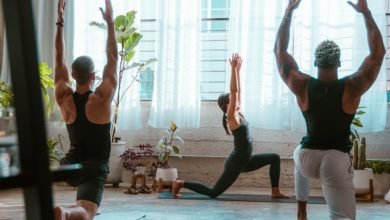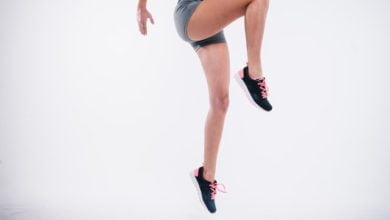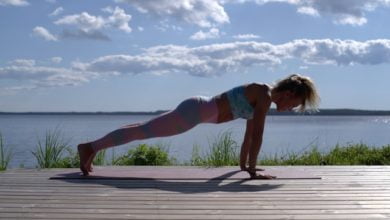Improved jumping technique with the basics

Improved jumping technique with the basics
Improving how to jump starts with the basics
Jumping is not for the faint of heart. In order to achieve success for you and your horse, it is important to learn how to jump properly to avoid confusing or throwing your horse off balance. Additionally, for your own safety as a passenger, learning a safe jump position will help keep you safe even when things don’t always go as planned.
To allow your horse to jump to its best potential, you must learn to be the kind of rider who stays out of his way and prepares him for maximum success on the fences. It all starts with being aware of your body and how your posture can affect your horse.
Sure, jumping has a pretty steep learning curve, and it can seem like a lot to remember, but there are a few simple ways you can break this down to make it easier to remember, and practice, aspects of your jumping position so that you and your horse can. They can become jump stars!
Smash the correct jump position
head and eyes
Most of us have heard “eyes raised” over and over in lessons. To jump in, this note is really no different. You want to keep your head elevated and your eyes focused and aware of where you’re going.
It can be tempting to look at your horse, jump, or even land, but this can lead to experimental errors due to not focusing on where you’re headed.
Watching where you’re heading and keeping your head in the full position, with your shoulders inclined to follow the direction of your head, will help. So, keep that head up and keep your eyes focused on where you’re going and where you want to point your horse.
body and seat
The reason riders come out of the saddle into a “two point” position over the fences is for aerodynamic purposes – to allow the horse to jump as easily as possible without obstruction from the rider. Putting you in the saddle is not only meant to help your horse come up with its athletic potential and get rid of jumping easily, but also to keep you safe and on the path without jumping too far in front of or behind the movement. Either of these could cause you to lose your balance and fall.
Your seat should be higher off the seat but with your center of balance still above the seat, with much of your weight and balance falling on the balls of your feet and in your heels as an anchor.
Your torso can move forward and closer toward the horse’s neck in a folded position, with your fulcrum at the hips and waist. You want a straight back, flat shoulders, and your eyes focused on what’s in front of you: looking between the horse’s ears when jumping as you approach.
You want to support your body without falling on the horse’s neck. As such, there should be a visible distance between you and the horse’s neck. When you fold at your hips to get into two points, you don’t want this to change where your legs are sitting. This aspect of the jumping pose focuses only on bending your body at the hips while your legs remain attached to the horse.
Arms, elbows and hands
It is important to give your horse a proper release over fences. There are different types of versions that can be used, but the most common one, especially with new jumpers, is the top version. This involves extending your arms partially up to the neck so that you can follow the horse’s mouth while it is hopping and avoid getting caught in the mouth.
If your elbows are too rigid and don’t follow the horse’s movement, you may accidentally push them in the mouth, which causes the horse to become confused, uncomfortable and more likely to take a rail.
You want your elbows to be loose and to follow the horse’s movement, but you don’t want to reach so far into the neck that you lose your balance and end up lying on the horse’s neck. When you fold at the hips to go into two points, you want to modify your elbows slightly by moving them forward as your torso naturally moves forward with the movement of the horse’s jump.
You can allow the movement of the jump to help guide your elbows if you keep them loose and tender.
If you fall behind, you can use your hands to “slide” the bridle by loosening your grip and letting them pass between your fingers so the horse doesn’t hit the end of the contact.
This is an easy way to self-correct if you find yourself taking too short a vacation or forgetting to release. It’s an important skill to learn and remember in case you get a bad distance or if things don’t go on track as planned. It allows you to try to stay out of your horse’s way even when your posture isn’t ideal.
legs and feet
Your legs and feet are what stabilize and balance your position on the fences. If your leg slips too far, your center of gravity is thrown off and it’s also harder to follow the horse’s movement and increases the likelihood of the rider off-balance.
If your feet are turning to the side rather than mostly facing forward, and roughly parallel to the horse’s rib cage, this inadvertently lifts your leg off the horse’s side and causes you to pinch your knees, making your leg less supportive. You and the horse.
You want your leg to fall just behind the collar, and your toes forward and your calf in contact with your horse’s body. The position of the leg over fences is no different from what is ideal on the flat, it is only your upper body that moves to follow the movement of the jump.
Your weight can fall into your heels, but be careful not to overstretch your heels as this will make them ineffective as an anchor for your body. The lower heel serves the functional purpose of helping you balance by stabilizing your weight.
jumping posture tips
See where you want to go.
eyes up! Anytime you look down, you don’t see where you’re going and that could lead to derailment or additional mistakes.
Let the horse jump at you.
Try not to push yourself forward with the horse as this can make you jump a lot before moving and can be difficult to fix. Try to allow the movement of the jump naturally to propel your body forward into two points.
Practice, practice, practice.
Practice riding in a half bench and two point flats so you can develop strength for a strong jumping position over fences. With training comes mastery! The more time you focus on strengthening your body to make it easier on yourself, the easier it will be to jump.
Building trust on the pillars of the earth.
Set up pole training courses and you can do them as boat poles – train your position, count your steps, and help your horse become more amenable to the fences. This way, when the jumps are high, you’ll be more confident and prepared.
Make sure the stirrup length is working.
In general, jumpers will shorten a hole or two from their flat length. Make sure the stirrups aren’t too long or too short as this can make it more difficult for you to work on the jumping position and get it right.
Gymnastics helps you get it right.
After making sure your trainer has approved your readiness, gymnastic nets can be an excellent tool to help you learn timing and body awareness – without having to worry about preparing your horse for the distances in the same way you might have to do on the track. Working the net allows you to ride your horse through combinations of poles or jumps and this helps you develop an awareness of your position as a rider so that you can feel it when it is right.
Jumping is just a steady action with obstacles.
You don’t need to jump all the time to improve! Lots of flat work to target your balance and your equation on the flat will turn your skills over the fences. Never underestimate the importance of flat work and trust that you will improve as a rider even if your coach focuses on the flat a lot.
Flat work is what makes a good jump. For both the horse and the rider, it is critical. You don’t just need to jump to improve your posture!
Practice on low fences.
When developing your site, keeping things easy is often the way to go. Don’t rush your way to the high walls. Stick to the low key and work on your foundation: your location. Once that’s done you can put up the fences, no problem. Do not rush! Having the time you need to be successful is what makes a good rider.
Passenger work does not help.
If you have a weak leg over fences or on flats, working without stirrups can really help strengthen your leg. Start with small steps and gradually expand the amount you do. Even not doing any stirrups down one long side or short side is a start!
Strengthening the muscle structures you need to develop a good, strong jumping posture will make it a lot easier. You can also work these muscle groups with home exercises that don’t require a horse.
To be tense just fine!
If you find yourself losing confidence, it’s okay to take a step back and slow down. Stand up for yourself and tell your coach when you’re really struggling with something or having a tough time. It’s totally normal to struggle when learning new concepts, don’t be embarrassed by this and just remember that it’s part of the journey.
parting thoughts
Learning to jump can seem like a huge undertaking and can be a little intimidating. While there is a lot to learn, it certainly can be done and you can learn all of these things in your own comfort zone, at your own pace, one step at a time.
Part of allowing yourself to become an excellent jump-jump rider that you’re destined to be is to focus on the essential parts of that, and you can start that off by focusing on subtle improvements in positioning that will add extra time until suddenly becoming the rider you’ve only dreamed of being .
Remember that every rider has their own individual weaknesses and struggles, so certain aspects of your jumping pose may be harder on you than they are for others, but these are just your individual struggles and it’s all part of your learning! Even the best riders in the world had to start from the beginning once.
When you learn new things, try to make it nice and interesting and don’t compare yourself to others. Try to beat the rider you were yesterday and focus on continuous personal improvement. That’s all anyone could ask for, and that’s how you become an accomplished racer.



